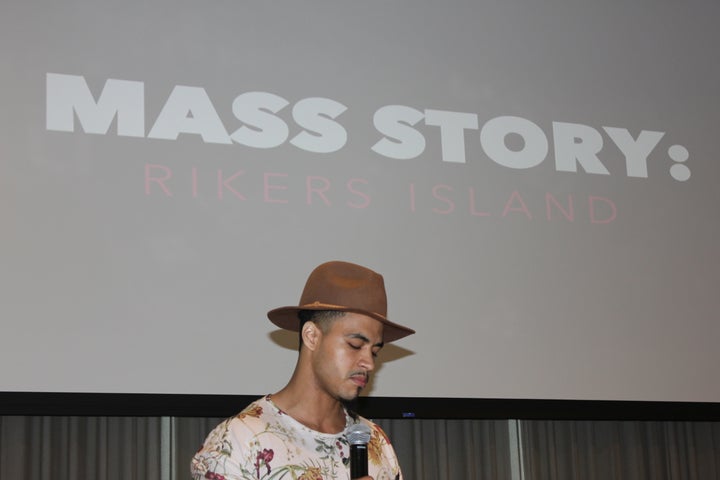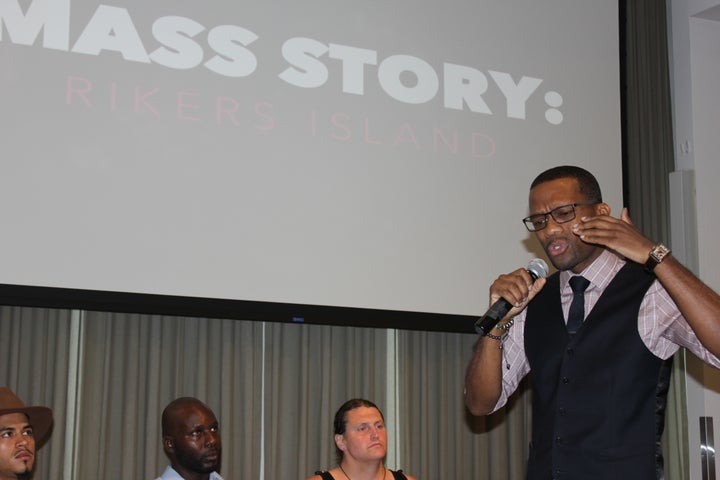
Recently my wife left a career in finance to pursue a less lucrative role in community organizing. The move was not wholly unexpected – Pam could handle the grueling hours of her old job, but she couldn’t find meaning in helping rich companies make more money. I’ve been intrigued to learn about the main draw of this new job, one that also keeps her working long hours, but with passion and determination.
This week I found out all I needed to know.
Pam has been working the frontlines of a campaign aimed at closing Rikers Island. You may have heard of Rikers and its jails, depending on how closely you follow New York politics or issues of mass incarceration. But it’s generally hard to graze beyond the surface of the topic unless you have a reason to be intimate with the issue.
On Wednesday, I attended “Mass Story,” an interactive lab put on by Piper Anderson at Create-Forward, Pam’s organization - JustLeadershipUSA, and Humanities Action Lab. I got to hear first-hand stories from formerly incarcerated individuals about their experiences at Rikers. And by the end, I became intimate with the issue.
I was also forced to confront my identity as a New Yorker, and forced to consider my duties as an American citizen.
The basic stats are important to know: that 80% of detainees at Rikers are awaiting trial, not yet convicted of a crime; that many misdemeanors can take more than 150 days to get resolved, and 500 days to get through to a jury; that it costs taxpayers $200k a year, per detainee; and that 40% of Rikers inmates are diagnosed with a mental illness, a number which grows the longer they’re detained.
There are currently around 8,000 people at Rikers. If you subtract people who are merely awaiting trial and those who need mental health treatment, you're left with a number of people who could possibly be housed in other New York City facilities.
But the numbers themselves are not as important as the faces and stories of the people affected by them. For Founder and President of JustLeadershipUSA Glenn Martin, the stories highlight why the place is beyond repair, beyond reform. It’s one thing to read about dehumanizing and corrupt practices; it’s another to hear from people who have lived through them.
Soon after the panel started, I began to understand what he meant.
I heard from the trans woman who was beat and sexually violated by both correctional officers and detainees for three days. They tried to move her into a different holding cell before a nurse forced them to take her to Columbia med. They brought her back to Rikers from the hospital before receiving official clearance to do so.
I heard from the 25-year-old man who spent years at Rikers, mostly awaiting his trial. He finally came home unable to reciprocate affection to his mother, unable to trust his best friends. At Rikers, he woke up every morning to do push-ups, not knowing when he would be attacked next; at home, he woke up from night-sweats thinking he was still there.
I heard from the now-reentry advocate, who was sentenced to months in solitary confinement for fighting. He needed to use a payphone which belonged to a gang, to which he did not belong. The officer in solitary had the same gang affiliation, and would go days without feeding him.
I heard from the mother. An immigrant who came to America to experience the liberty and freedom she had always heard about, only to have her son sent away to await his trial for 6 years. After being thrown into this fray of constant violence, he took a plea deal, just this week, unable to fight back against the system, anymore.
And I heard from the former correctional officer. Who, during a mic-share, spoke up from the audience, crying, claiming that it was all true.
I wasn’t just hearing. I was listening. Seeing, feeling, connecting.
As a sociologist I’m surrounded by facts, papers, articles which evidence the reproductive nature of systems of inequality. They show clear patterns about demographics, about neighborhoods, about who gets arrested. They highlight that the system can leave those who have been through it with incurable pain and suffering. These types of trauma not only affect the individuals themselves, but affect their families, their children, their communities, and subsequent generations.
The system reproduces these things. It doesn't correct them; it maintains them.
Reading about it isn’t quite as humanizing as hearing someone tell it to you. And I know that by writing this without a story of my own to share, I am being hypocritical, and doing the same thing.
But more of the puzzle came together for me this week. So I feel the need to share.
After the panel, we did a line activity, where one end of the room represented “Closing Rikers” and the other “Reforming Rikers.” We were told to disperse and stand along the spectrum for what we thought was possible and necessary.
People defended their positions with statements ranging from, “Mass incarceration is modern slavery, and slavery had to be abolished not reformed,” to, “Slavery reformed into mass incarceration, and if we close Rikers, it will just reform into something new.”
Standing somewhere near the middle, my mind reverted to my classroom, where I run similar activities with my students. When I’m with them, I think about ideology and common belief systems. I try to get my students to pick sides that they may not even agree with, for purposes of good debate.
I wondered if people realized that we were in a room of like-minded people, with many shared beliefs. That many people outside this room held a different view, and would consider our conversation radical. That to effect any change, they are the people we should be talking to. That’s the real challenge.
Then I realized that’s what my wife Pam and these organizations do on a daily basis. They go out to communities, build coalitions, speak with people, and try to change minds. Or at least have conversations. That’s a feat worth taking on.
The analogy of slavery is a good one. Changing that ideology from being considered “natural” to inhumane, took decades, even after abolition.
Anderson, who moderated the event asked, “If Rikers were to close, would that do any good? Would it at least send a message about the incarceration problem around this country?”
The room let out a resounding and collective, “YES!”
And while the road to achieve that abolition may be long, accompanied by many functional, legislative, and institutional alternatives in its place, it’s worth the effort.
Mass Story Lab is launching nationally, traveling to twenty cities, following this debut in New York. The next lab will take place in Riverside, CA on August 6th.
To Pam and all those fighting that good fight, I’m proud of you. Get it done.
Anindya Kundu is a doctoral candidate in Sociology of Education at NYU. His book Achieving Agency: Raising Collective Responsibilities in Education to Help All Students Succeed comes out in 2017 (Rowman and Littlefield).

